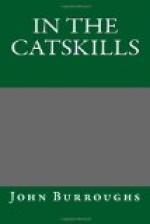His career of frolic and festivity begins in the fall, after the birds have left us and the holiday spirit of nature has commenced to subside. How absorbing the pastime of the sportsman who goes to the woods in the still October morning in quest of him! You step lightly across the threshold of the forest, and sit down upon the first log or rock to await the signals. It is so still that the ear suddenly seems to have acquired new powers, and there is no movement to confuse the eye. Presently you hear the rustling of a branch, and see it sway or spring as the squirrel leaps from or to it; or else you hear a disturbance in the dry leaves, and mark one running upon the ground. He has probably seen the intruder, and, not liking his stealthy movements, desires to avoid a nearer acquaintance. Now he mounts a stump to see if the way is clear, then pauses a moment at the foot of a tree to take his bearings, his tail, as he skims along, undulating behind him, and adding to the easy grace and dignity of his movements. Or else you are first advised of his proximity by the dropping of a false nut, or the fragments of the shucks rattling upon the leaves. Or, again, after contemplating you awhile unobserved, and making up his mind that you are not dangerous, he strikes an attitude on a branch, and commences to quack and bark, with an accompanying movement of his tail. Late in the afternoon, when the same stillness reigns, the same scenes are repeated. There is a black variety, quite rare, but mating freely with the gray, from which he seems to be distinguished only in color.
The track of the red squirrel may be known by its smaller size. He is more common and less dignified than the gray, and oftener guilty of petty larceny about the barns and grain-fields. He is most abundant in old barkpeelings, and low, dilapidated hemlocks, from which he makes excursions to the fields and orchards, spinning along the tops of the fences, which afford not only convenient lines of communication, but a safe retreat if danger threatens. He loves to linger about the orchard; and, sitting upright on the topmost stone in the wall, or on the tallest stake in the fence, chipping up an apple for the seeds, his tail conforming to the curve of his back, his paws shifting and turning the apple, he is a pretty sight, and his bright, pert appearance atones for all the mischief he does. At home, in the woods, he is the most frolicsome and loquacious. The appearance of anything unusual, if, after contemplating it a moment, he concludes it not dangerous, excites his unbounded mirth and ridicule, and he snickers and chatters, hardly able to contain himself; now darting up the trunk of a tree and squealing in derision, then hopping into position on a limb and dancing to the music of his own cackle, and all for your special benefit.




